| Teffont Evias | |
|---|---|
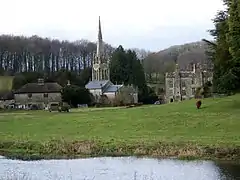 | |
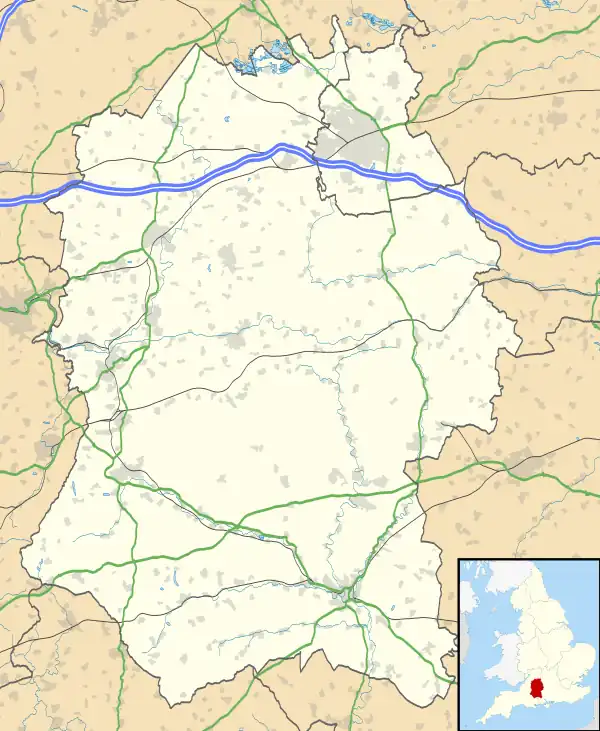 Teffont Evias Location within Wiltshire | |
| OS grid reference | ST993312 |
| Civil parish | |
| Unitary authority | |
| Ceremonial county | |
| Region | |
| Country | England |
| Sovereign state | United Kingdom |
| Post town | Salisbury |
| Postcode district | SP3 |
| Dialling code | 01722 |
| Police | Wiltshire |
| Fire | Dorset and Wiltshire |
| Ambulance | South Western |
| UK Parliament | |
Teffont Evias is a small village and former civil parish, now in the parish of Teffont, on the Nadder valley in the south of Wiltshire, England. Edric Holmes described the village as "most delightfully situated",[1] and Maurice Hewlett included Teffont in his list of the half dozen most beautiful villages in England.[2] The present buildings are mostly of local stone, and several are thatched.
The civil parish was combined in 1934 with neighbouring Teffont Magna to form a united Teffont parish.
Location
Teffont Evias lies 3 miles (5 km) northeast of the large village of Tisbury and 6+1⁄2 miles (10 km) west of Wilton. The southern boundary of both the former Teffont Evias parish, and the modern Teffont parish, is the River Nadder. The village street follows a stream which rises at Teffont Magna and flows south to join the Nadder.[3]
Geology
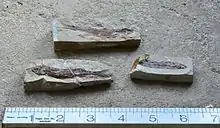
Purbeck limestone underlies almost all of the parish, with a ridge of Cretaceous Upper Greensand. Teffont Evias Quarry and Lane Cutting is protected as a geological Site of Special Scientific Interest, where fossils include some of the best Purbeck fish, with crocodile, turtle, and insect remains.[4] The Chilmark Quarries extend under Teffont and some of the disused entrances are within Teffont parish.
In the 13th century, Teffont Evias's quarries of Purbeck limestone at the southern end of the former parish were the source of much of the freestone used in the building of Salisbury Cathedral.[5]
History
A silver stater of the pre-Roman Durotriges tribe has been found in Teffont[6] which may have been near the boundary of Durotrigian territory. The modern name derives from "Teo", an old Germanic word meaning a boundary, and the Late Latin word "fontana", meaning a spring of water.[7] The perennial stream rises at Spring Head at the north end of Teffont Magna, and flows some 2.5 km south to its debouchment into the River Nadder.
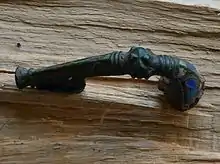
Early Saxon remains have not been found to the west of the stream, and the original boundary may have separated the Romano-British from the Anglo-Saxons.[8] The "Ewyas" element derives from Ewyas Harold in Herefordshire's Golden Valley, the main seat of Alfred of Marlborough, lord of Tefonte at the time of Domesday Book.[9][3] From Saxon times the village has been generally on the valley bottom along the course of the stream; the Teffont Archaeology Project found remains of Roman settlement, possibly a sacred site, on higher ground.[10]
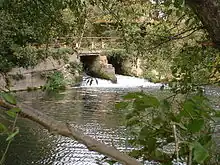
For administration, including punishment of misconduct, the village formed part of Dunworth hundred; in 1502 its tithingman was presented to the hundred court for not carrying a staff as precedent required.[11]
According to Wilson's Imperial Gazetteer of England and Wales (1870–1872):
TEFFONT-EVIAS, a parish in Tisbury district, Wilts; 1¼ mile W of Dinton r. station, and 6½ W of Wilton. It has a post-office, of the name of Teffont, under Salisbury. Acres, 742. Rated property, £1,177. Pop., 163. Houses, 32. The property is all in one estate. The living is a rectory in the diocese of Salisbury. Value, £240.* Patron, W. F. De Salis, Esq. The church is good.[12]
The civil parishes of Teffont Magna and Teffont Evias were combined on 1 April 1934 to form Teffont parish.[3][13] The population of Teffont Evias in 1931 had been 98.[14]
Buildings
.jpg.webp)
These are scattered along the valley of the south-flowing stream and the road, in irregular clumps giving views of the woods and fields. The manor house[15] and its adjoining church date largely from the 15th century, with significant embellishments and extensions especially in the 19th century;[3] to the east of the manor house a former lodge from early in that century is in rubble stone under a thatched roof.[16]
There are several workers' cottages in vernacular styles, some with carved dates in the 1600s. The house known as Bridges, built in the 18th century and extended and altered in 1842,[17] was the rectory until 1939.[3] William and Emily Fane de Salis paid for the building of a small school in the 1860s (closed in 1876 after Teffont Magna school opened)[18][3] and opposite it, in 1883, a pair of almshouses (now Acacia Cottages).[19]
Church
.jpg.webp)
The Anglican Church of St Michael and All Angels is Grade II* listed. The present building, in local rubble stone and ashlar with a tiled roof, is largely a rebuilding of 1824–26 to designs of Charles Fowler, at the expense of John Mayne.[20] A church is first mentioned in the 12th century but the structure prior to the rebuilding was from the 16th and 17th; the Ley family's north chapel of 1630 was retained while the chancel and nave were rebuilt with higher walls, a north aisle was added, and the northwest tower was built.[3] The buttressed tower has three stages and a parapet with four spirelets; between 1830 and 1843 a tall recessed spire was added.[3]
Pevsner writes: "It is an impressive steeple, and indeed an impressive church, rising on the lawn of the Manor House".[21]
Interior
Inside are effigies and tombs of Henry Ley (d. 1574) and his two sons, and an early 19th-century reredos. Sir Walter Raleigh mentions the church of "Tevont Evias" in his Discoverie of Guiana (1596), in connection with the Ley family.[22] Windows have pieces of medieval glass and 17th-century roundels.[20] The three bells were cast in the 17th century.[23]
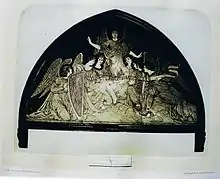
There is also a marble tarsia panel by Henri de Triqueti, who went on to work in the Albert Memorial Chapel at Windsor Castle. Installed in 1863, the panel was commissioned by Emily Fane de Salis and depicts the choir of angels.[24]
Parish
The rectory was united in 1922 with the newly created benefice of Teffont Magna (until then a chapelry of Dinton), retaining the rectory house at Teffont Evias.[25] The benefice was held in plurality with Dinton from 1952.[26] In 1979 the benefice became part of a group ministry,[27] today called the Nadder Valley team and covering fourteen parishes with sixteen churches.[28] The church's parish registers survive in the Wiltshire and Swindon History Centre for the following dates: christenings 1684–1991, marriages 1701–1994, and burials 1683–1991.[29]
In 1914 the Reverend Sir Douglas Edward Scott, 7th Baronet, was appointed as the parish's rector. Shortly afterwards he was declared bankrupt and his rectorship terminated; four years later, he was convicted of bigamy and imprisoned.[30]
Governance
Teffont Evias is now part of the parish of Teffont, which has a parish council and is in the area of the Wiltshire Council unitary authority, which is responsible for almost all significant local government functions. It falls within the South West Wiltshire parliamentary constituency and the serving Member of Parliament is Andrew Murrison.
Proprietors of the manor
Thomas Hungerford (d.1397) bought a 114-acre estate at Teffont Evias in 1377–8.[3] The estate continued in the Hungerford family but after the attainder in 1461 of Robert Hungerford, 3rd Baron Hungerford it was granted to Richard, Duke of Gloucester, later Richard III. The attainder was reversed in 1485 and the manor was restored to Walter Hungerford of Farleigh (d.1516). His grandson Walter, later 1st Baron Hungerford of Heytesbury, inherited in 1522 but in 1540 he was attainted by act of parliament and executed for treason, sorcery, and offences forbidden by the Buggery Act 1533, with his estate forfeited to the Crown.[31]
The Crown granted the manor to Henry Ley (d.1574), whose descendant James – created Earl of Marlborough in 1626 – sold it to John Ash in 1652. His grandson sold it to Christopher Mayne in 1692, and ownership was to continue in the Mayne family until 1907.[3]
%252C_Mrs_Fane_De_Salis_from_1859.jpg.webp)
Christopher Mayne (1655–1701), descendant of a prosperous though plebeian Exeter family, bought the manor in 1679 for £12,000 and moved there in 1692. The manor continued in the Mayne family until it was sold in 1802, then was bought back in 1813 by John Thomas Mayne, FRS, FSA, (1792–1843),[3] of the Honourable Society of the Inner Temple.[32] In response to the severe distress of the labouring population and the ensuing riots, he became an "indefatigable reformer", circulating a petition for parliamentary reform and reduced expenditure which was signed by over 14,000 inhabitants of the county, and presented to Parliament on 10 February 1831.[33]
With friends, J. T. Mayne enlarged Teffont Evias church and gave it its present tower and steeple. He also extended and remodelled the manor house, and increased the woodland in the parish.[3] He attempted to improve his family tree: he included in it connections (which he could not document) to two West Country clergymen, the Catholic (now Saint) Cuthbert Mayne and the Anglican Jasper Mayne, and he spent many days researching and copying the documents of the aristocratic, extinct Mayne family of Kent, then claiming them (and some of their portraits, one still in Teffont) as his own ancestors.[34]
From 1852 until her death in 1896, J. T. Mayne's eldest daughter Emily, and her husband William Fane de Salis, were in charge. They built the present service court and water tower of the manor house. Their marriage was childless, so on Emily's death in 1896 the house and estate passed to her next unmarried sister Margaret (d.1905), then to the youngest sister Ellen-Flora (1829–1907), Mrs. Maurice Keatinge, and thence to Ellen's eldest son Richard Keatinge. He sold it to his younger brothers Maurice Walter and Gerald Francis (1872–1965),[35] who shared the advowson of the benefice of Teffont Evias with the patrons of the church of Dinton.[36] Maurice died childless and in 1947 Gerald passed the estate to his son Edgar Keatinge (1905–1998), later Sir Edgar, who had been a Conservative MP for a short time. In 1958 the advowson was transferred to the Bishop of Salisbury.[37]
Notable people
- James Ley, 1st Earl of Marlborough, later Lord High Treasurer of England, was born at Teffont Evias ca. 1552.[38]
- Henry Ley, 2nd Earl of Marlborough, lived at the manor house from 1635.[39]
- William Fane de Salis (1812–1896) married the heiress of the Mayne family and made Teffont Evias his country seat.
- Sir Edgar Keatinge (died 1998), a former politician, owned and farmed the remainder of the estate from 1947.
- Paffard Keatinge-Clay, architect and sculptor, was born in Teffont Evias in 1926.
- Hermione Baddeley (1906–1986), actress, and her socialite husband David Tennant rented the manor house in 1934[40] and used it as a venue for boisterous parties (including mixed naked bathing in the goldfish pond).[41]
- Group Captain Frank Willan (1915–1981), distinguished RAF officer, later chairman of Wiltshire County Council, lived at Bridges in later life until his death.
References

- ↑ Wanderings in Wessex. An Exploration of the Southern Realm from Itchen to Otter p249. London: Robert Scott. 1922, no ISBN. Accessed 1 May 2020 via Project Gutenberg
- ↑ Lyall Ford (2001). Poorhouse to Paradise: The Adventures of a Pioneering Family in a North Queensland Country Town. Lyall Ford. p. 3. ISBN 978-0-646-33254-3.
- 1 2 3 4 5 6 7 8 9 10 11 12 Freeman, Jane; Stevenson, Janet H (1987). Crowley, D.A. (ed.). "Victoria County History: Wiltshire: Vol 13 pp185-195 – Parishes: Teffont Evias". British History Online. University of London. Retrieved 1 May 2020.
- ↑ Needham John E. (2011) Forests of the Dinosaurs. Wiltshire's Jurassic Finale. s.v. Teffont. ISBN 978-1-906978-01-3, Hobnob Press, East Knoyle
- ↑ Sylvanus Urban, wd., The Gentleman's Magazine, and Historical Chronicle (1830), p. 105 online at books.google.com
- ↑ "Record ID: WILT-5EB2DF – IRON AGE coin". The Portable Antiquities Scheme. The British Museum. Retrieved 1 May 2020.
- ↑ Margaret Gelling (11 October 2007). Latin loan-words in Old English place names. Vol. 6. Cambridge University Press. p. 9. ISBN 978-0-521-03863-8.
{{cite book}}:|work=ignored (help) - ↑ Bruce Eagles, in Roman Wiltshire and After: Papers in Honour of Ken Annable, ed. Peter Ellis. Publisher: Wiltshire Archaeological & Natural History Society. Date September 2001. ISBN 0-947723-08-0, ISBN 978-0-947723-08-8
- ↑ Teffont Evias in the Domesday Book
- ↑ "Roman Settlement Site". Teffont Archaeology Project. 2014. Archived from the original on 28 March 2014.
- ↑ Freeman, Jane; Stevenson, Janet H (1987). Crowley, D.A. (ed.). "Victoria County History: Wiltshire: Dunworth hundred". British History Online. University of London. Retrieved 1 May 2020.
- ↑ Teffont Evias at visionofbritain.org.uk
- ↑ "Relationships and changes Teffont Evias CP/AP through time". A Vision of Britain through Time. Retrieved 6 December 2023.
- ↑ "Teffont Evias AP/CP through time: Relationships and changes". A Vision of Britain through Time. University of Portsmouth. Retrieved 5 May 2020.
- ↑ Historic England. "Teffont Manor with Two Attached Follies (1250965)". National Heritage List for England. Retrieved 1 May 2020.
- ↑ Historic England. "The Lodge (1146260)". National Heritage List for England. Retrieved 2 May 2020.
- ↑ Historic England. "Bridges (1318681)". National Heritage List for England. Retrieved 2 May 2020.
- ↑ Historic England. "Manor School Bungalow (1250871)". National Heritage List for England. Retrieved 5 May 2020.
- ↑ Historic England. "Acacia Cottages (1146270)". National Heritage List for England. Retrieved 5 May 2020.
- 1 2 Historic England. "Church of St Michael and All Angels (1146266)". National Heritage List for England. Retrieved 2 May 2020.
- ↑ Pevsner, Nikolaus; Cherry, Bridget (revision) (1975) [1963]. Wiltshire. The Buildings of England (2nd ed.). Harmondsworth: Penguin Books. p. 518. ISBN 0-14-0710-26-4.
- ↑ Joyce Lorimer, ed., Sir Walter Ralegh's Discoverie of Guiana, p. 308 online at books.google.com
- ↑ "Teffont Evias". Dove's Guide for Church Bell Ringers. Retrieved 2 May 2020.
- ↑ Darby, Elisabeth (2002). "A French Sculptor in Wiltshire: Henri de Triqueti's Panel in the Church of St. Michael & All Angels, Teffont Evias". Wiltshire Archaeological and Natural History Magazine. 95: 34-45. Retrieved 4 May 2020 – via Internet Archive.
- ↑ "No. 32762". The London Gazette. 31 October 1922. pp. 7662–7663.
- ↑ "No. 39606". The London Gazette. 25 July 1952. pp. 4008–4009.
- ↑ "No. 48010". The London Gazette. 20 November 1979. p. 14600.
- ↑ "Nadder Valley (Team Ministry)". A Church Near You. Retrieved 3 May 2020.
- ↑ Teffont Evias at genuki.org.uk. Retrieved 9 November 2010.
- ↑ Allen, Peter (10 June 2011). "(title unknown)". Great Barr Observer: 8.
- ↑ Parliament Roll, 31 & 32 Henry VIII, m. 42. In Harrison, William Jerome (1891). "Hungerford, Walter (1503–1540)". In Lee, Sidney. Dictionary of National Biography 28. London: Smith, Elder & Co. pp. 259–261.
- ↑ "Will of John Thomas Mayne". The National Archives. 30 August 1843. Retrieved 5 May 2020.
- ↑ "Wiltshire 1820–1832". History of Parliament Online. Retrieved 3 May 2020.
- ↑ Soldiers, Saints, and Scallywags. David Gore. Wiltshire Family History Society 1997, pp.15–18. Published by the author, 2009.
- ↑ Audrey McBain and Lynette Nelson, The Bounding Spring (Black Horse Press, 2003, ISBN 1-904377-26-2)
- ↑ 'Teffont Magna', in A History of the County of Wiltshire, Volume 8: Warminster, Westbury and Whorwellsdown Hundreds (1965), pp. 74–78, accessed 7 July 2011.
- ↑ "No. 41299". The London Gazette. 31 January 1958. p. 687.
- ↑ Anthony Wood, Athenae Oxoniensis, vol. 2 (1692), p. 487 online
- ↑ "LEY, Henry (1595-1638), of Heywood House, Heywood, Wilts. and Lincoln's Inn, London; later of Teffont Evias, Wilts". History of Parliament Online. Retrieved 4 May 2020.
- ↑ "Three-year story of village where 'much has happened'". The Wiltshire Gazette and Herald. 2 June 2004. Retrieved 4 May 2020.
- ↑ Lesley Bates. Three-year story of village where 'much has happened'. Salisbury Journal. 4 March 2004. page 31.
Further reading
- A social history of the village was published in 2003, entitled "The Bounding Spring" (Audrey McBain and Lynette Nelson. ISBN 1-904377-26-2. Black Horse Press, 2003.
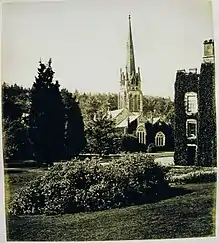
External links
- Village website
- Teffont Evias at GENUKI
- Teffont Village Design Statement 2007. Approved at Wiltshire Council's Southern Area Planning Committee on 24 January 2013 as a material planning consideration. Accessed 14 November 2015.
- The Teffont Archaeology Project
![]() Media related to Teffont Evias at Wikimedia Commons
Media related to Teffont Evias at Wikimedia Commons